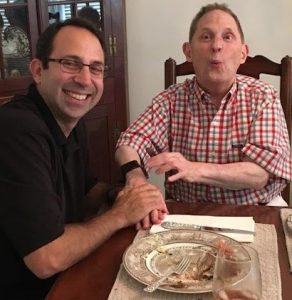This article is a reprint of an article running in the winter edition of the Administration for Community Living Title VI newsletter.
By: Jolie Crowder, PhD, MSN, RN, CCM
International Association For Indigenous Aging
The last ten days, I had a front-row seat to dementia caregiving when my husband’s mother came to stay with us as she was moving into a memory care apartment near us. It was a close-up view not just into dementia caregiving but also into broken “systems” and missing support.
My husband is the primary caregiver for both his mom and her brother. He is also the only one of his generation left in the immediate family, the only child and grandchild.  His mom has moderate-severe vascular dementia that has taken a turn for the worse in the last several months. She had been staying in the family home with her 72-year-old intellectually disabled brother. He passed away unexpectedly during the ten days she was with us. Their mom died two years ago, right at the start of COVID. My husband was also her primary caregiver until she passed. So, not his first caregiving rodeo.
His mom has moderate-severe vascular dementia that has taken a turn for the worse in the last several months. She had been staying in the family home with her 72-year-old intellectually disabled brother. He passed away unexpectedly during the ten days she was with us. Their mom died two years ago, right at the start of COVID. My husband was also her primary caregiver until she passed. So, not his first caregiving rodeo.
My husband managed their care from our house a couple of hours away, routinely driving back and forth for everyone’s doctor’s appointments. He also took care of the upkeep for both houses and the bills for his mom and uncle. His mom receives a small pension from her state job. His grandmother had thankfully put some money aside to help cover long-term care needs for both of their children. Otherwise, I have no idea what their living situation and our lives would look like.
His mom and uncle had amazing caregivers (not formally trained) who came in to help almost around the clock that my husband coordinated. When the paid caregivers needed time off, it usually meant my husband had to take time off from his job or spend the weekend there. Taking on everyday tasks like meals, meds, and bathing. His mom suffers from incontinence. So, every morning includes a big load of laundry, trash runs, scrubbing bed covers and floors, and a lot of effort to try to convince her a shower is a good thing. I swear, it is like listening to the “dementia whisperer” when he talks to her. If he can’t convince a person to do something with his kind, soothing voice, nobody can. Sadly, a shower is/ was never in the cards most days. At least not without dozens of attempts, hours passing, or a battle of wills. Thanks to the challenging behavior changes that have taken hold from dementia. Apathy. Depression. Resistance.
It’s a lot. Some days I can see he just barely keeps it together. He is not alone. According to the National Institute on Aging, more than 40 million people provide unpaid care for someone each year. One in three (1 in 3) American Indian and Alaska Native adults are caregivers. That is more than the general population. Like my husband, more than half of those folks have provided care for more than two years.
Research has found that while caregiving is rewarding, it is a challenge and presents a lot of long-term risks and challenges, including: depression, anxiety, heart disease, cancer, diabetes, acute injuries (e.g., sprains or strains).
Dementia caregiving is tough and takes more than a mental and physical toll. A 2015 article estimated that families of people with dementia spend $61,522 a year in the last 5 years of life— almost twice as much as those who died of other causes. Minorities, people with lower education and lower incomes, are more likely to have higher out-of-pocket costs from dementia. My husband had to take an unpaid leave of absence last month to help care for both his uncle and his mom. This was after using up all of his paid sick and vacation leave for the year, mostly taking care of them. He is still out of work.
The caregiving role is tough, but the worst part is how almost impossible it feels to find help and access supports and services. Trying to navigate both the health care and aging “systems” most days was (and is) almost more than my husband can stand. Getting a person just to answer the phone or return a call in less than a week is a miracle. What he really needs is a live person to give him time, answers, and follow-through. Not a form letter eight weeks later from Medicaid notifying him that his uncle’s application was finally approved. A week after he passed away.
The one bright spot in the hunt for services and supports has been memory care facilities. Yet, few families have the resources to afford them. Safe, accessible spaces; meaningful socialization; emotional support; appropriate therapies; trained staff; interdisciplinary approaches to care coordination. These shouldn’t be considered luxuries for people living with dementia and their caregivers.
We can do more, and we can do better for caregivers and people living with dementia. For all caregivers really. Consider doing one thing today: read an article, pick a program or service you can start, engage in community conversations with caregivers, or just pick up the phone when caregivers call.
Check out some of the following resources or trainings for ideas.
• Visit the American Indian and Alaska Native Resource Center for Brain Health Online Resource Library for more tools.
If you are willing to share resources in our online resource library, please send them to [email protected].
